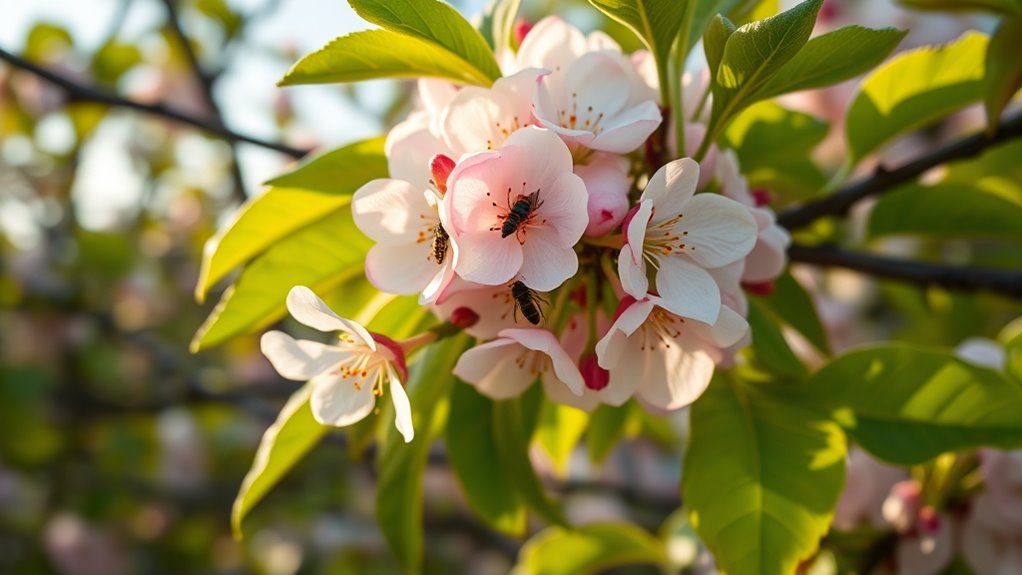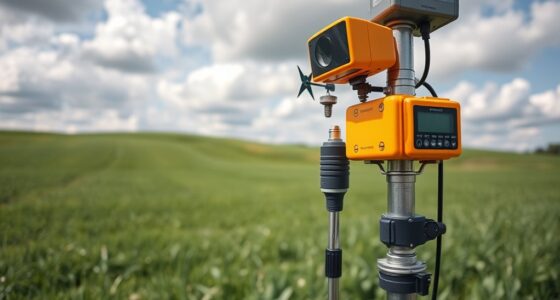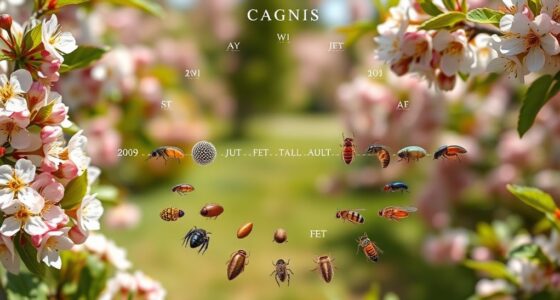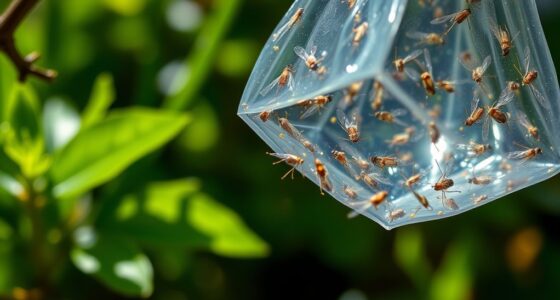Forecasting pest emergence with phenology involves tracking key biological events like egg laying and adult flight while monitoring environmental cues such as temperature, humidity, and seasonal changes. By understanding how these factors influence pest development stages, you can predict when pests will emerge and peak activity. This proactive approach allows you to plan timely management strategies, reducing damage and chemical use. Keep exploring to learn how to apply these insights effectively for your pest control efforts.
Key Takeaways
- Monitoring biological events like egg laying and adult flight helps predict pest emergence accurately.
- Environmental cues such as temperature and humidity influence key phenological stages.
- Regional climate variability requires adapting phenological models for precise forecasting.
- Incorporating climate data enhances the timing accuracy of pest emergence predictions.
- Accurate phenological forecasts enable proactive pest management, reducing reliance on reactive controls.

Have you ever wondered how farmers and pest control experts predict when pests will appear? The answer lies in understanding the pest lifecycle and how environmental factors influence it. Pest lifecycle refers to the stages a pest goes through from egg to adult, and each stage is affected by specific cues in the environment. By monitoring these cues, you can anticipate when pests will emerge and plan your management strategies accordingly. Climate impact plays a *vital* role here, as temperature, humidity, and seasonal patterns directly affect the timing of each stage in the pest lifecycle. For instance, warmer temperatures often accelerate development, leading to earlier outbreaks, while cooler conditions may delay emergence. Recognizing these climate-driven changes helps you forecast pest activity more accurately and reduces the reliance on reactive measures.
Understanding pest lifecycle cues and climate effects helps forecast pest emergence and optimize management strategies.
Phenology, the study of periodic biological events, offers valuable insights into pest emergence. By tracking the timing of key events—like egg laying, larval hatch, or adult flight—you can predict upcoming pest populations with greater precision. This approach requires observing specific life cycle indicators and relating them to climatic conditions. For example, if you notice certain pests tend to lay eggs after a particular temperature threshold is reached, you can use weather data to forecast when those thresholds will be met. This proactive strategy allows you to implement control measures before pest populations reach damaging levels, saving both time and resources.
Furthermore, climate impact isn’t uniform across regions; it varies with local conditions, making phenological models adaptable to specific areas. This means you can tailor your pest management efforts based on regional climate patterns, rather than relying on generic schedules. As climate change continues to influence weather patterns, understanding these impacts becomes even more critical. Shifts in temperature and rainfall can alter pest development timelines, sometimes leading to more frequent or severe infestations. By integrating climate data into phenological predictions, you stay ahead of these changes, ensuring your pest control efforts are timely and effective.
In essence, combining knowledge of pest lifecycle stages with climate impact and phenology allows you to forecast pest emergence accurately. This integrated approach provides a clearer picture of when pests will appear, giving you the advantage to act preemptively. You’ll be able to optimize your pest management strategies, reduce chemical usage, and protect your crops or property more sustainably. Staying informed about environmental cues and biological events helps you anticipate pest problems rather than just react to them, making your efforts more efficient and environmentally responsible.
Frequently Asked Questions
How Accurate Are Phenology-Based Pest Forecasts?
You can expect phenology-based pest forecasts to be fairly accurate when predicting pest life cycles, especially if you consider local climate conditions. These methods improve forecasting accuracy by tracking specific developmental stages of pests, helping you time control measures effectively. However, variability in weather and environmental factors can sometimes affect precision. Overall, phenology provides a reliable tool, but it’s best to combine it with other monitoring methods for ideal results.
What Environmental Factors Influence Pest Phenology Predictions?
Ironically, predicting pest phenology is all about embracing unpredictability. You should consider temperature effects, which can accelerate or delay pest development unexpectedly. Host plant interactions also play a vital role—they might seem straightforward, but pests often respond unpredictably to plant cues. So, while you rely on environmental factors, remember that climate variability and complex host relationships keep pest forecasting both challenging and fascinating.
Can Phenology Models Predict Emerging Pest Resistance?
Yes, phenology models can help predict emerging pest resistance by tracking genetic adaptation over time. By understanding how pests evolve in response to control measures, you can adjust your pest management strategies proactively. These models provide insights into resistance development, enabling you to implement targeted interventions before resistance becomes widespread. This proactive approach helps maintain effective control and reduces crop damage caused by resistant pests.
How Do Climate Change Impacts Affect Pest Emergence Forecasts?
Climate variability alters pest emergence forecasts by creating unpredictable patterns, making it harder for you to rely solely on historical data. You must consider how increased temperatures and irregular weather influence pest adaptation, prompting earlier or more frequent emergence. These changes challenge phenology models, requiring you to update predictions continually. As pests adapt faster to shifting climates, your forecasting tools need to incorporate climate change impacts for more accurate, timely pest management decisions.
Are Phenology Models Applicable to All Pest Species Globally?
Phenology models aren’t universally applicable to all pest species due to species variability and regional differences. You need to take into account each pest’s unique life cycle and environmental responses, which can vary greatly across regions. While these models work well for some pests, others may require tailored approaches. So, always assess species-specific traits and regional factors before applying phenology models broadly to ensure accurate pest emergence predictions.
Conclusion
By understanding and predicting pest emergence through phenology, you might find that timing truly is everything. Sometimes, nature’s patterns align unexpectedly, offering clues that can help you better prepare and respond. As you connect these dots, it’s almost as if the environment gives you a gentle nudge—reminding you that insight often comes from paying close attention to subtle cues. In the end, embracing this coincidence could make all the difference in managing pests effectively.









